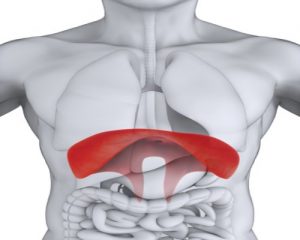 Diaphragm pain affects the dome-shaped muscle that separates the thorax (chest) from the abdomen. This muscle plays an important role in the breathing process. When we take a deep breath in, our diaphragm decreases the amount of pressure in the lungs and expands the ribs, allowing the lungs to fill up with air. When we exhale, the diaphragm relaxes, elevating back into its original position due to its elastic nature as air exits the body. It then rests in its normal dome-shaped position until another breath is taken.
Diaphragm pain affects the dome-shaped muscle that separates the thorax (chest) from the abdomen. This muscle plays an important role in the breathing process. When we take a deep breath in, our diaphragm decreases the amount of pressure in the lungs and expands the ribs, allowing the lungs to fill up with air. When we exhale, the diaphragm relaxes, elevating back into its original position due to its elastic nature as air exits the body. It then rests in its normal dome-shaped position until another breath is taken.
Diaphragm muscle pain can be a symptom of many different medical problems and is a common complication during surgical procedures. However, in many cases, pain in the diaphragm is unknown.
Anatomy of diaphragm pain
Advertisement
The muscles of the diaphragm originate along the lumbar vertebra of the spine (lower back area), the inferior border of the ribs (at the 6th rib level) and sternum (breastbone). An opening exists in the middle portion of the diaphragm to for structures such as the esophagus, the descending aorta, and the vena cava vein to pass through between the thoracic and abdominal cavities. Nerves such as the phrenic and vagus nerves also pass through this opening.
The diaphragm effectively makes up the floor of the thoracic cavity with its contractions as we inhale, drawing it down into the abdominal cavity, allowing the thoracic cavity to become deeper and larger as it draws air from the surrounding atmosphere.
The function of the diaphragm allows for several actions that are important for several expulsive acts. These include coughing, sneezing, vomiting, and even expelling feces. It is also believed that the diaphragmatic spasm upon breathing in air can lead to the development of hiccups.
Causes of diaphragm pain
It can be very difficult to diagnose diaphragm pain without the aid of a medical professional, as the condition often presents as an additional symptom of a preexisting condition. However, feeling pain during exhalation may indicate diaphragmatic pain, while pain felt during inhalation may be more likely due to problems with the abdominal muscles. Diaphragm muscle strain symptoms can be described as being sharp or stitching in nature. Diaphragm pain causes may include the following medical conditions.
Anatomic defects:
- Congenital
Appear at birth with the majority of cases having unknown origins.
- Acquired
Appear after certain types of injuries or trauma. This includes being a post-operative complication for injures mistakenly caused by doctors during procedures (iatrogenic). Sometimes, it is not known why diaphragm pain occurs (idiopathic)
Innervation defects leading to diaphragmatic pain:
Disorders of the spinal cord: Includes spinal trauma, amyotrophic lateral sclerosis (ALS), and motor neuron disease.
- Myasthenia gravis: An autoimmune disorder characterized by weakness in the skeletal muscles, especially in the muscles responsible for breathing affecting breathing capacity.
- Stroke: Can cause one side of the diaphragm muscle to become paralyzed with the unaffected side having to work harder eventually leading to diaphragmatic pain development.
- Neuropathy of the phrenic nerve: Directly innervates the diaphragm. Injury to the phrenic nerve via surgical injury or otherwise can lead to severe diaphragmatic pain.
Other causes:
- Hiatal hernia: Characterized by contents of the abdominal cavity, such as the stomach or intestines, protruding upwards into the thoracic cavity through the esophageal opening in the diaphragm called the esophageal hiatus. Hiatal hernias commonly occur in the older population (60+) but can be seen in younger patients who smoke, perform frequent heavy lifting, or are obese. Symptoms often include chest pain, difficulty swallowing, and frequent hiccups.
- Diaphragmatic rupture: Occurs due to a tear that occurs in the diaphragm caused by blunt trauma, such as a motor vehicle accident. While relatively rare, this condition is often overlooked and requires surgery, as it will not heal on its own.
- Pain during pregnancy: As the uterus expands, the diaphragm may be pushed upward about one and a half inches, decreasing overall lung capacity. This can cause shortness of breath in the mother but is considered a normal phenomenon and not of any concern. It is advised for pregnant women to see their doctor if they experience any difficulty breathing during their pregnancy.
Additional causes leading to diaphragmatic pain include:
- Muscular dystrophy
- Rheumatoid arthritis
- Poliomyelitis
- Thyroid disorders
- Malnutrition
- Radiation therapy
- Infection
- Trauma
- Inefficient breathing pattern
- Chiropractic manipulation
Treatment for diaphragm pain
Diaphragm pain treatment will often depend on the underlying condition leading to its development. This may involve surgical correction for congenital and acquired forms, neurologic medication and physical therapy for the treatment and prevention of stroke and disorders of the spinal cord, or even implanting a phrenic nerve pacemaker for the treatment of phrenic nerve neuropathy.
Advertisement
Causes of a hiatal hernia involves lifestyle changes which include losing weight, improving posture, exercising, and dietary changes.
Once the appropriate treatment has been implemented for your particular case of diaphragm pain, symptoms will often subside as the recovery process continues. However, it is important to stay in close contact with your doctor as it is possible for hernias to recur and other treatment modalities to fail if not strictly adhered to.
Related: Stabbing pain in chest: Causes and treatment
